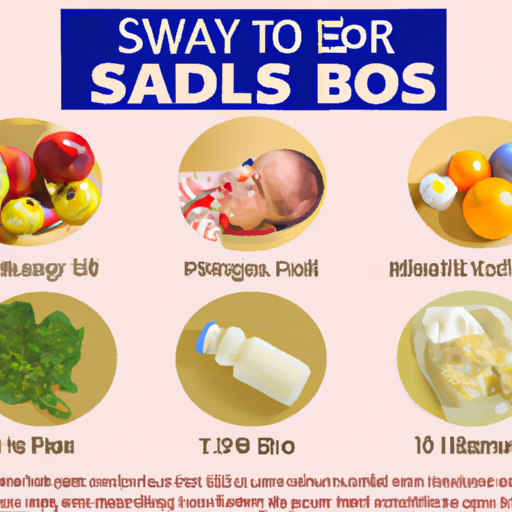In this article, we’ll be discussing some helpful tips for introducing solids to your baby. We understand that this can be an exciting but also an overwhelming time for parents, so we’re here to offer some guidance. Throughout this article, you’ll learn about the importance of starting with single-ingredient foods, how to gradually introduce new foods, and the significance of letting your baby lead the way. By following these tips, you’ll be well-equipped to navigate this new stage of your baby’s development. So, let’s get started!

Start with Single Grain Cereal
Choose a mild cereal
When it comes to introducing solids to your baby, the first step is typically starting with a single grain cereal. These cereals are often made from rice or oats and provide a smooth and easily digestible option for your little one. It’s important to choose a mild cereal that is specifically made for infants, as it will be more gentle on their developing digestive system.
Mix with breastmilk or formula
To prepare the cereal, simply mix it with breastmilk or formula to create a thin and easily spoonable consistency. This will make it easier for your baby to swallow and digest. Start with a small amount, such as one or two teaspoons, and gradually increase the quantity as your baby becomes more comfortable with eating solid foods.
Start with small amounts
When introducing solids to your baby, it’s important to start with small amounts. This allows their digestive system to adjust to the new foods and prevents any potential digestive issues. Begin by offering just a few spoonfuls of cereal at each feeding and gradually increase the quantity as your baby develops their eating skills.
Introduce one new food at a time
As you and your baby become more comfortable with the single grain cereal, you can start introducing other pureed foods. It’s important to introduce one new food at a time, waiting a few days before introducing another. This allows you to monitor your baby for any potential allergic reactions or digestive issues that may arise from the new food.
Look for Signs of Readiness
Baby can sit up with support
Before introducing solids, it’s important to ensure that your baby is developmentally ready. One of the key signs of readiness is the ability to sit up with support. This indicates that your baby has gained enough neck and head control to safely swallow solid foods.
Shows interest in food
Another sign of readiness is your baby showing interest in food. They may begin to reach for your food or watch you intently as you eat. This demonstrates that they are curious about what you’re eating and may be ready to start exploring new flavors and textures.
Can coordinate swallowing
Coordinating swallowing is an essential skill for your baby when it comes to eating solid foods. Before introducing solids, your baby should be able to move food to the back of their mouth and swallow it without significant gagging or choking.
Loses the tongue-thrust reflex
The tongue-thrust reflex is a natural reflex that infants have, which causes them to push their tongue forward in response to the presence of a foreign object in their mouth. This reflex is important for breastfeeding but can interfere with eating solids. Once your baby has lost this reflex, usually around 4-6 months of age, they may be ready to start trying solid foods.

Texture and Consistency
Gradually increase thickness
As your baby becomes more comfortable with the single grain cereal, you can gradually increase the thickness of the purees you offer. This allows them to begin experiencing different textures and helps them develop their chewing and swallowing skills. Start with thin purees and gradually work your way up to thicker, mashed foods.
Progress from purees to mashed foods
Once your baby has mastered purees, you can start introducing mashed foods. Mashed foods provide a slightly thicker texture that helps your baby transition to more solid foods. You can mash soft fruits and vegetables, such as avocados or bananas, to create a creamy and easy-to-eat texture.
Introduce soft finger foods
As your baby becomes more comfortable with chewing and swallowing, you can start introducing soft finger foods. These foods allow your baby to practice picking up food and bringing it to their mouth, which helps develop their fine motor skills. Soft finger foods can include steamed vegetables, small pieces of soft fruit, or cooked pasta.
Encourage self-feeding
Once your baby has developed the ability to pick up finger foods, it’s important to encourage self-feeding. This allows them to explore different textures, tastes, and smells on their own and helps develop their independence and self-confidence. Offer a variety of finger foods that are safe and easy for your baby to pick up, such as small pieces of cooked chicken or soft cooked vegetables.
Offer a Variety of Foods
Include fruits and vegetables
When it comes to introducing solids to your baby, it’s important to offer a variety of fruits and vegetables. These foods are packed with essential vitamins, minerals, and fiber that are important for your baby’s growth and development. Start with mild options, such as mashed bananas or pureed sweet potatoes, and gradually introduce a wider variety of flavors and textures.
Introduce lean proteins
As your baby continues to explore solid foods, it’s important to introduce lean proteins into their diet. Lean proteins, such as pureed chicken or mashed beans, provide essential nutrients, including iron and zinc, that are crucial for your baby’s growth and development. Be sure to thoroughly cook the proteins and mash or puree them to a smooth consistency.
Try different grain options
In addition to single grain cereals, you can also start introducing other grain options to your baby. This can include mashed or pureed brown rice, oatmeal, or quinoa. These grains provide important nutrients, including fiber and carbohydrates, that are important for your baby’s energy and digestive health.
Incorporate dairy or alternatives
Around 6-8 months of age, you can start introducing dairy or dairy alternatives into your baby’s diet. This can include plain yogurt, mashed cheese, or pureed tofu. These foods provide important nutrients, including calcium and protein, that are important for your baby’s bone and muscle development. Be sure to choose plain options without added sugars or sweeteners.

Be Mindful of Allergies
Introduce common allergens one at a time
When introducing solid foods to your baby, it’s important to be mindful of potential allergies. It’s recommended to introduce common allergenic foods, such as peanuts, tree nuts, eggs, and fish, one at a time. This allows you to monitor your baby for any potential allergic reactions and identify the specific food that may be causing the reaction.
Watch for any adverse reactions
As you introduce new foods to your baby, it’s important to watch for any adverse reactions. These can include symptoms such as rash, hives, vomiting, diarrhea, or difficulty breathing. If your baby has any of these symptoms after eating a new food, stop offering it and consult with a pediatrician.
Consult with a pediatrician if needed
If you have any concerns or questions about introducing solids to your baby, it’s important to consult with a pediatrician. They can provide personalized advice and guidance based on your baby’s specific needs and medical history. They may also recommend further allergy testing if your baby has a family history of food allergies.
Keep a food diary
To help keep track of the foods you introduce to your baby and any potential reactions, it can be helpful to keep a food diary. This allows you to easily identify any patterns or triggers that may be causing an adverse reaction. Include the date, time, and details of the foods your baby eats, as well as any symptoms they experience.
Avoid Added Sugar and Salt
Choose unsweetened options
When selecting foods for your baby, it’s important to choose unsweetened options whenever possible. Added sugars can contribute to tooth decay and can also lead to a preference for sweet foods later in life. Instead, focus on providing naturally sweet options, such as fruits, and avoid offering foods with added sugars or sweeteners.
Limit processed and packaged foods
Processed and packaged foods often contain high amounts of salt and other additives that are not suitable for babies. These foods can also lack important nutrients and can contribute to unhealthy eating habits. Instead, focus on offering whole, fresh foods that are prepared at home.
Avoid adding salt or sugar to baby’s food
When preparing homemade baby food, it’s important to avoid adding salt or sugar. Babies do not need added salt or sugar in their diet, and too much can be harmful to their developing kidneys and teeth. Instead, rely on natural flavors from fruits, vegetables, and spices to enhance the taste of the foods you prepare for your baby.
Read labels carefully
When purchasing commercial baby food or products, it’s important to read labels carefully. Look for options that are low in added sugars and salt. Avoid products that contain artificial sweeteners, preservatives, or other additives that are not suitable for babies. Opt for organic options whenever possible to reduce exposure to pesticides and other chemicals.

Offer a Balanced Diet
Include a variety of food groups
To ensure your baby receives a balanced diet, it’s important to include a variety of food groups in their meals. This includes fruits, vegetables, lean proteins, grains, and dairy or alternatives. Each food group provides important nutrients that are crucial for your baby’s growth and development.
Ensure adequate iron intake
Iron is an essential nutrient for your baby’s brain development and overall growth. Ensure that your baby’s diet includes iron-rich foods, such as fortified cereals, pureed meats, beans, and leafy green vegetables. Vitamin C-rich foods, such as oranges or strawberries, can enhance iron absorption, so try offering these foods alongside iron-rich options.
Provide healthy fats
Healthy fats are important for your baby’s brain development and overall health. Include foods that are rich in healthy fats, such as avocados, pureed nut butters, and mashed fish. These foods provide essential omega-3 fatty acids that are crucial for your baby’s cognitive development.
Offer foods rich in vitamins and minerals
In addition to iron and healthy fats, it’s important to offer foods that are rich in vitamins and minerals. This includes foods such as carrots and sweet potatoes, which are high in vitamin A, and citrus fruits, which are high in vitamin C. Remember to offer a variety of fruits and vegetables to ensure your baby receives a wide range of important nutrients.
Watch for Choking Hazards
Avoid small, hard, or round foods
When offering finger foods to your baby, it’s important to avoid small, hard, or round foods that can pose a choking hazard. Examples include nuts, grapes, popcorn, and hot dog pieces. Instead, focus on offering soft, easily mashable foods that can be easily gummed or mashed by your baby.
Cut food into small pieces
When preparing finger foods for your baby, it’s important to cut them into small, bite-sized pieces. This helps prevent choking and makes it easier for your baby to handle and chew the food. Cutting foods into small pieces also helps your baby develop their fine motor skills as they learn to pick up and manipulate the food in their hands.
Supervise closely during mealtimes
To ensure your baby’s safety during mealtimes, it’s crucial to supervise them closely. Stay within arm’s reach of your baby and keep a close eye on them as they eat. This allows you to quickly react if your baby starts choking or shows signs of distress. Never leave your baby unattended while they are eating.
Learn infant CPR
As a parent, it’s essential to be prepared for any emergency, including choking. Consider taking an infant CPR class to learn the proper techniques for dealing with choking and other emergencies. Having this knowledge can give you the confidence and skills to act quickly and effectively in case of an emergency.

Slowly Increase Feeding Frequency
Start with one feeding per day
When you first introduce solids to your baby, start with one feeding per day. This allows their digestive system to adjust to the new foods and helps prevent any potential digestive issues. Choose a time during the day when your baby is alert and not overly hungry or tired.
Gradually increase to two or three meals
As your baby becomes more comfortable with solids, you can gradually increase the frequency of feedings. This typically involves adding a second meal and eventually a third meal to their daily routine. Pay attention to your baby’s hunger cues and adjust the frequency of feedings as needed.
Offer snacks in between
In addition to main meals, you can also start offering snacks to your baby as they become more comfortable with solid foods. These snacks can include soft and easily chewable options, such as pieces of ripe fruit or cooked carrots. Be mindful of portion sizes and avoid offering snacks too close to mealtimes.
Respond to baby’s hunger cues
As you introduce solids and increase the frequency of feedings, it’s important to respond to your baby’s hunger cues. Watch for signs of hunger, such as increased alertness, smacking lips, or reaching for food. Offer meals and snacks when your baby shows signs of hunger, rather than adhering to a strict schedule.
Conclusion
Introducing solids to your baby is an exciting milestone in their development. It’s important to approach this process with patience, awareness, and an understanding that every baby is unique. Remember to adjust the approach based on your baby’s individual needs and preferences. Enjoy the journey of introducing solids, as it is an opportunity to explore new flavors, textures, and smells. Always prioritize safety and nutrition, and consult with a pediatrician if you have any concerns or questions along the way.





